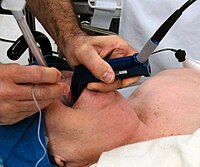
Photo from wikipedia
Introduction Anesthesiologists are exposed to the risk of infection from various secretions or droplets from the respiratory tract of patients. We aimed to determine bacterial exposure to anesthesiologists’ faces during… Click to show full abstract
Introduction Anesthesiologists are exposed to the risk of infection from various secretions or droplets from the respiratory tract of patients. We aimed to determine bacterial exposure to anesthesiologists’ faces during endotracheal intubation and extubation. Methods Six resident anesthesiologists performed 66 intubation and 66 extubation procedures in patients undergoing elective otorhinolaryngology surgeries. Sampling was performed by swabbing the face shields twice in an overlapping slalom pattern, before and after each procedure. Samples for pre-intubation and pre-extubation were collected immediately after wearing the face shield at the time of anesthesia induction and at the end of the surgery, respectively. Post-intubation samples were collected after the injection of anesthetic drugs, positive pressure mask ventilation, endotracheal intubation, and confirmation of intubation success. Post-extubation samples were collected after endotracheal tube suction, oral suction, extubation, and confirmation of spontaneous breathing and stable vital signs. All swabs were cultured for 48 h, and bacterial growth was confirmed by colony forming unit (CFU) count. Results There was no bacterial growth in either pre- or post-intubation bacterial cultures. In contrast, while there was no bacterial growth in pre-extubation samples, 15.2% of post-extubation samples were CFU+ (0/66 [0%] vs 10/66 [15.2%], p=0.001). All the CFU+ samples belonged to 47 patients with post-extubation coughing, and the CFU count was correlated with the number of coughing episodes during the process of extubation (P < 0.01, correlation coefficient= 0.403). Conclusion The current study shows the actual chance of bacterial exposure to the anesthesiologist’s face during the patient awakening process after general anesthesia. Given the correlation between the CFU count and the number of coughing episodes, we recommend anesthesiologists to use appropriate facial protection equipment during this procedure.
Journal Title: Infection and Drug Resistance
Year Published: 2023
Link to full text (if available)
Share on Social Media: Sign Up to like & get
recommendations!